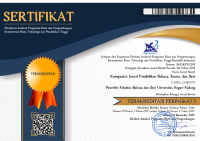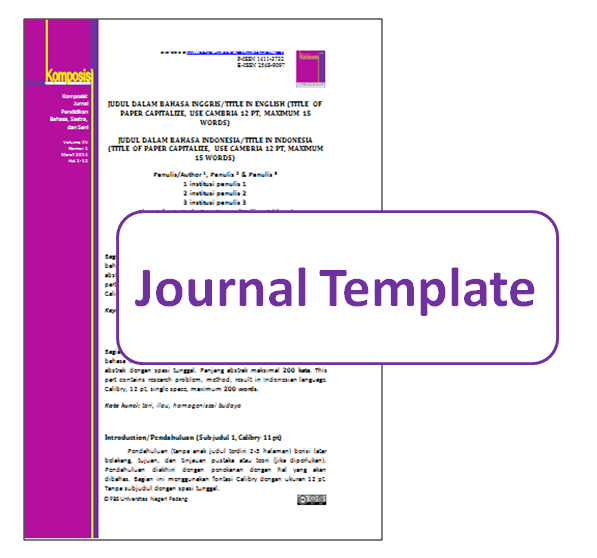Learning Process Experiment through Peer Tutoring in the Typography Subject from Students Learning Motivation of Arts Department FBS UNP
 ), Syafei Syafei(2), Yofita Sandra(3), Ernis Ernis(4),
), Syafei Syafei(2), Yofita Sandra(3), Ernis Ernis(4), (1) FBS Universitas Negeri Padang
(2) FBS Universitas Negeri Padang
(3) FBS Universitas Negeri Padang
(4) FBS Universitas Negeri Padang
 Corresponding Author
Corresponding Author
Copyright (c) 2023 Komposisi: Jurnal Pendidikan Bahasa, Sastra, dan Seni
DOI : https://doi.org/10.24036/komposisi.v23i2.119040
Full Text:
 Language : en
Language : en
Abstract
Keywords
References
Arikunto, S. (2002). Prosedur Penelitian Suatu Pendekatan Praktek. Rineka Cipta.
Djamarah, S. B. (2002). Psikologi Belajar. Rineka Cipta.
Irianto, A. (2004). Statistik Konsep dasar dan Aplikasinya. Prenada Media.
Prayitno, E. (1989). Motivasi Dalam Belajar. P2LPTK Ditjen Pendidikan Tinggi Depdikbud.
Riduwan. (2006). Belajar Mudah Penelitian Untuk Guru, Karyawan, dan Peneliti Muda. Alfabeta.
Sardiman. (2008). Interaksi dan Motivai Belajar Mengajar. PT. Raja Grafindo Persada.
Semiawan, C. dkk. (1987). Pendekatan Keterampilan Proses Bagaimana Mengaktifkan Siswa Belajar. Gramedia.
Setiawati, L. (2008). Analisis Diagnostik Kesulitan Belajar Matematika Melalui Bantuan Tutor Sebaya.
Sudjana, N. (2004). Dasar-Dasar Proses Belajar Mengajar. Sinar Baru.
Suhadi. (2008). Motivasi Belajar-Gunakan Mahasiswa Pandai Menjadi Tutor Sebaya Bagi Temannya.
Suryabrata, S. (2000). Psikologi Pendidikan. PT. Raja Grafindo Persada.
Suwanda. (2007). Pengelolaan Pembelajaran Tutor Sebaya. online.
Suyanto. (2006). Pengaruh Bantuan Tutor Sebaya Dalam Pembelajaran Kooperatif Tipe TGT terhadap Prestasi Belajar Mahasiswa SMP.
Syahroni, F. (2014). . Persepsi Siswa Terhadap Manfaat Pelaksanaan Praktek Kerja Industri Di SMKN 1 Lembah Gumanti. Jurnal Bahana Manajemen Pendidikan. Administrasi Pendidikan, 2(1), 275 ‐ 831.
Wikarya, Y. (2018). Tipografi & Kaligrafi,. Pendidikan Seni Rupa FBS Universitas Negeri Padang.
 Article Metrics
Article Metrics
 Abstract Views : 265 times
Abstract Views : 265 times
 PDF Downloaded : 48 times
PDF Downloaded : 48 times
Refbacks
- There are currently no refbacks.
Copyright (c) 2023 Komposisi: Jurnal Pendidikan Bahasa, Sastra, dan Seni

This work is licensed under a Creative Commons Attribution-NonCommercial 4.0 International License.











